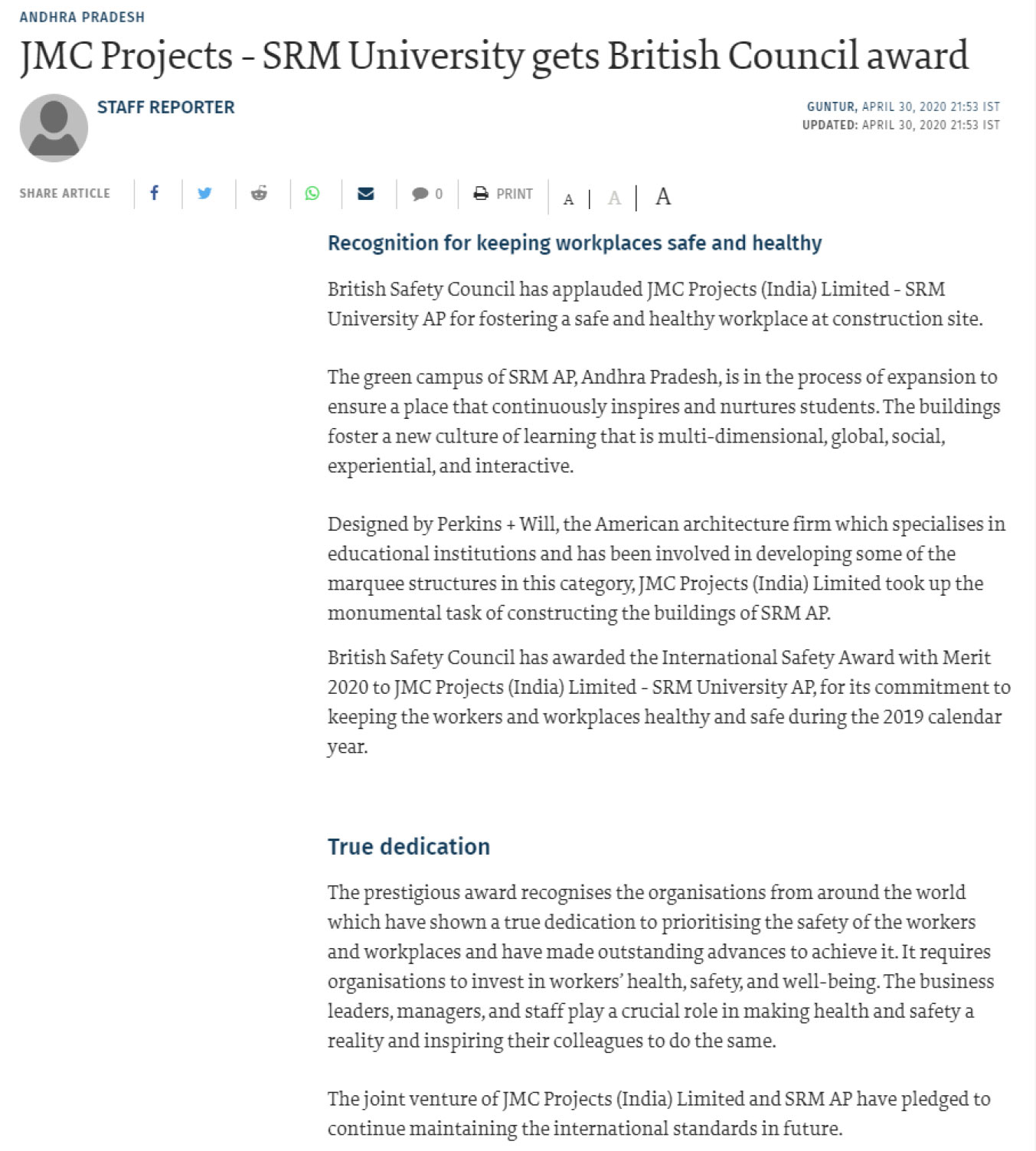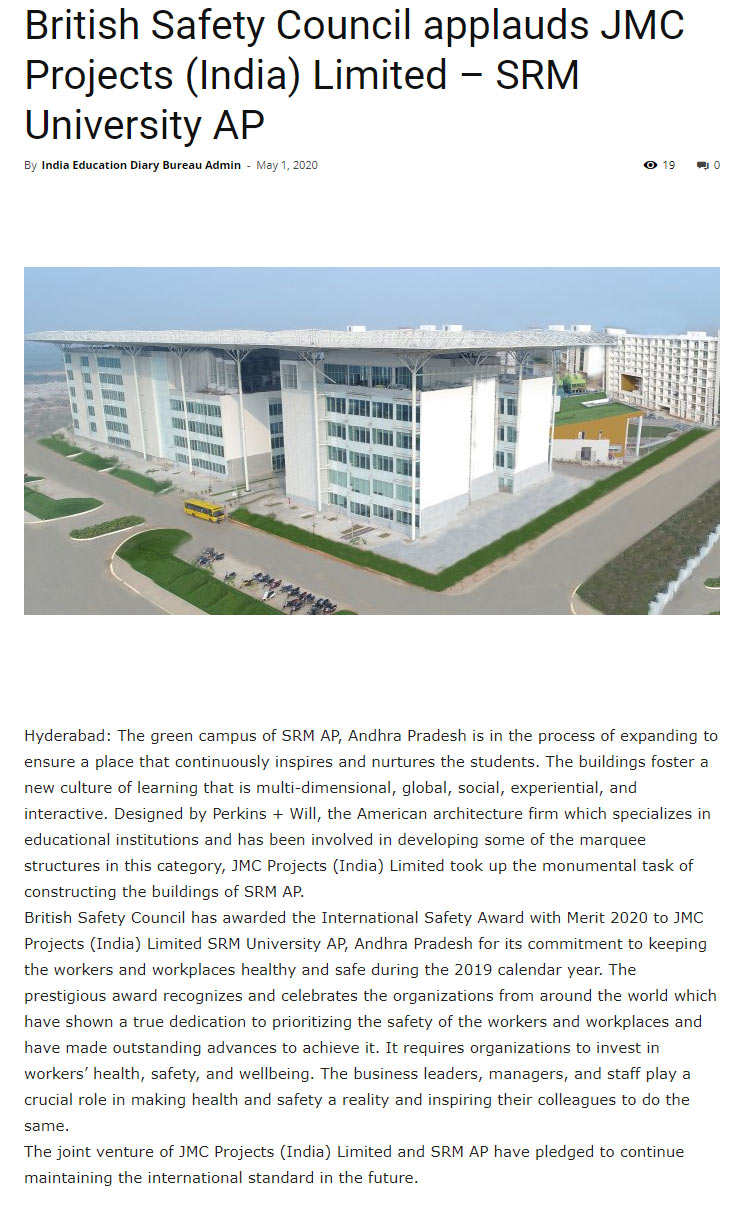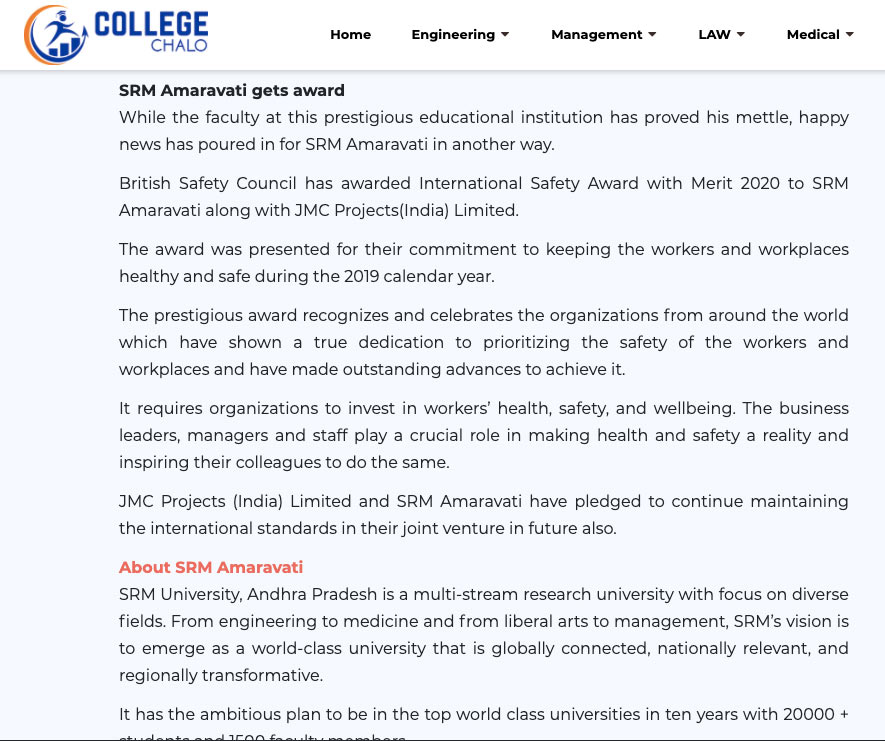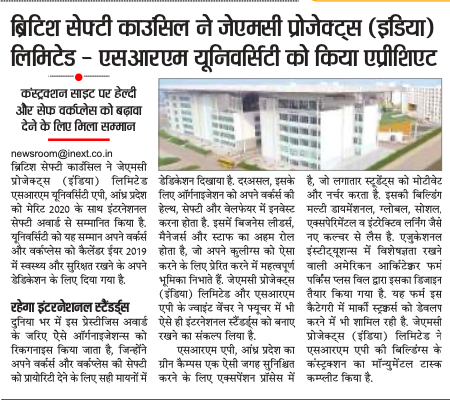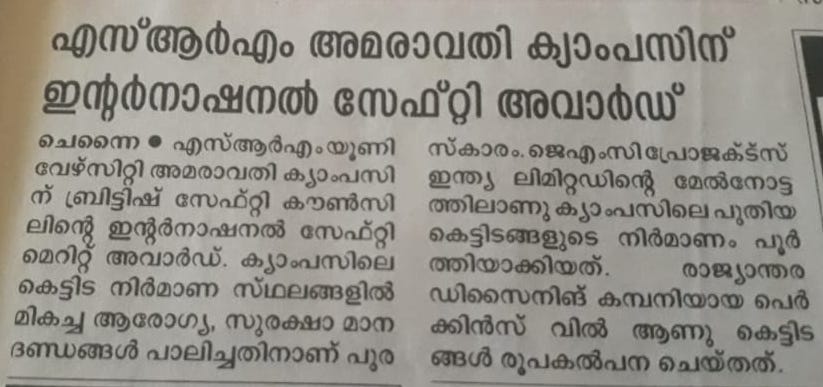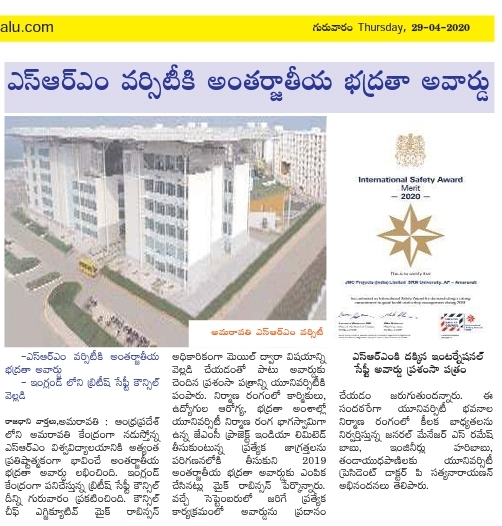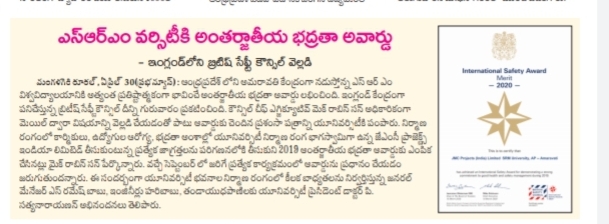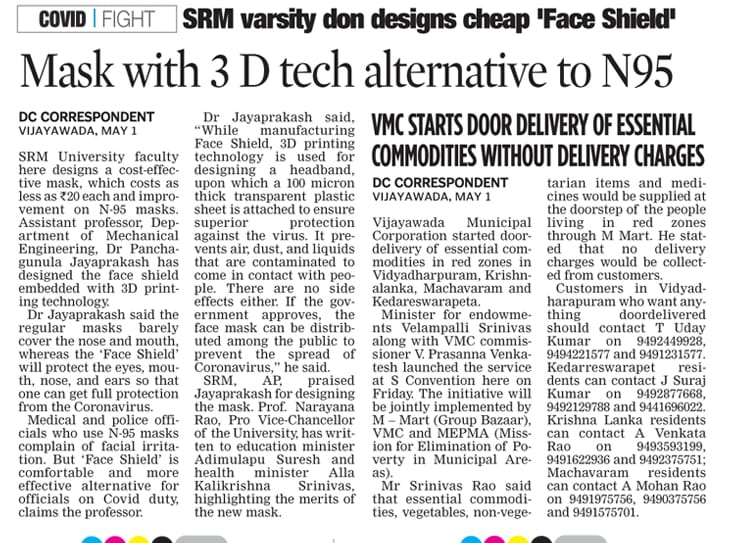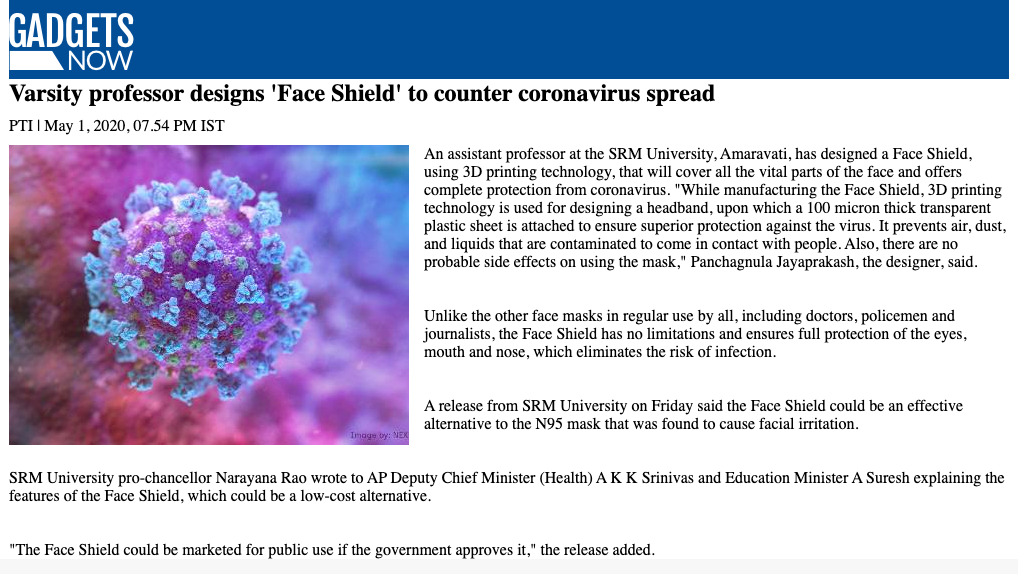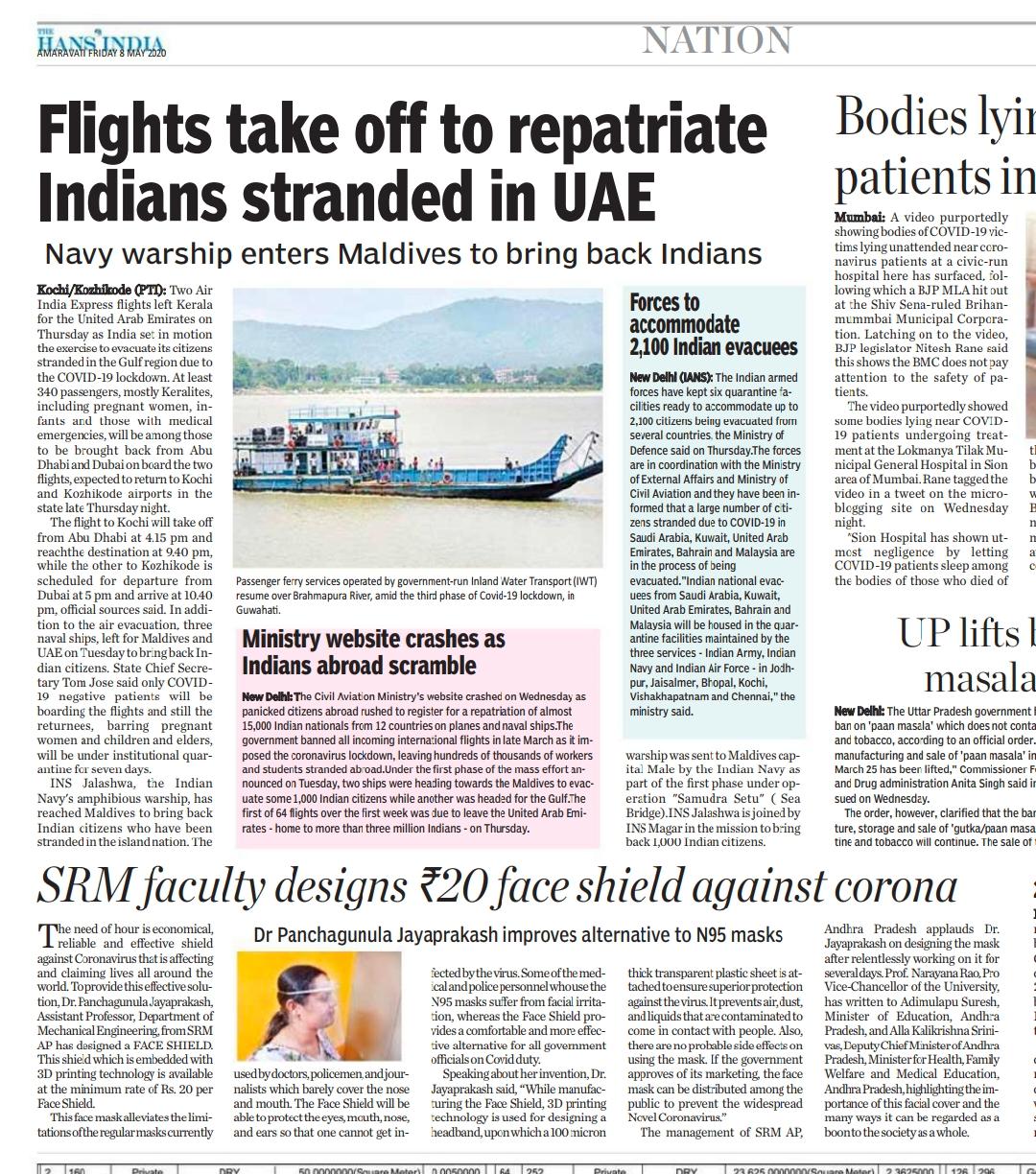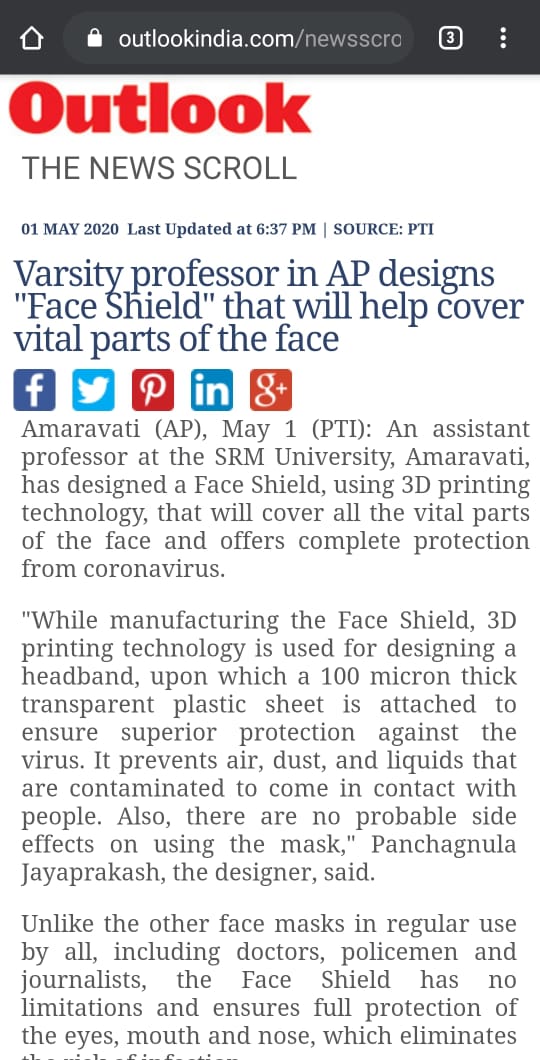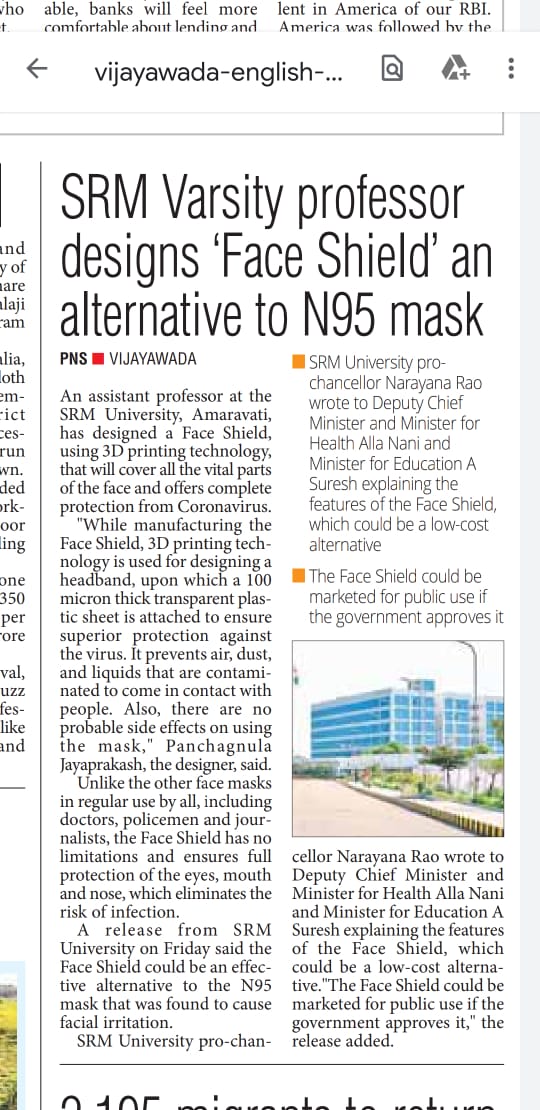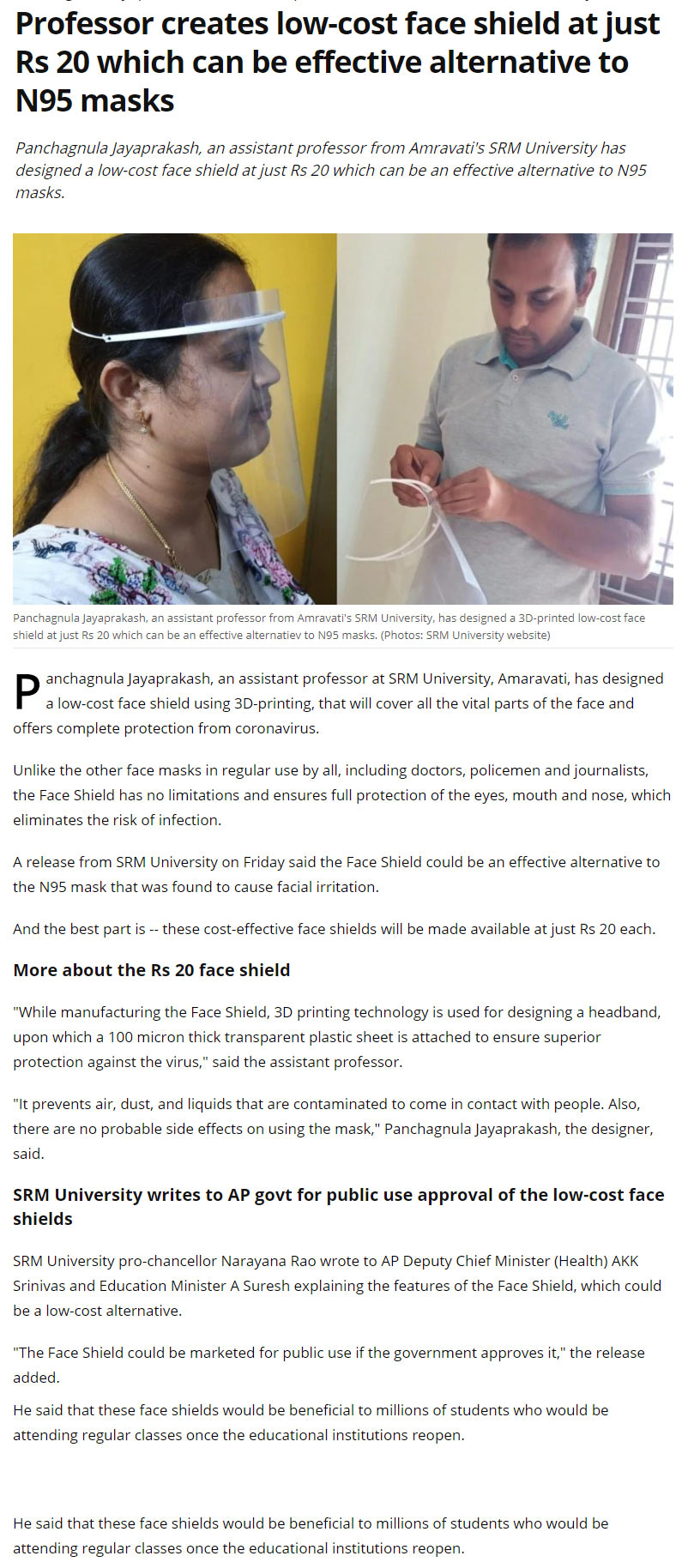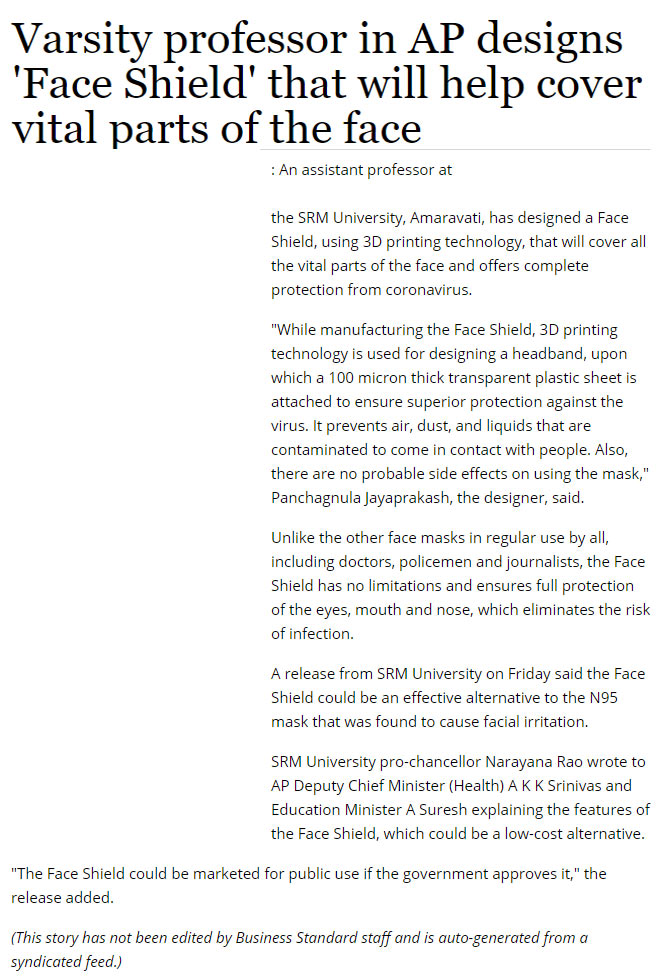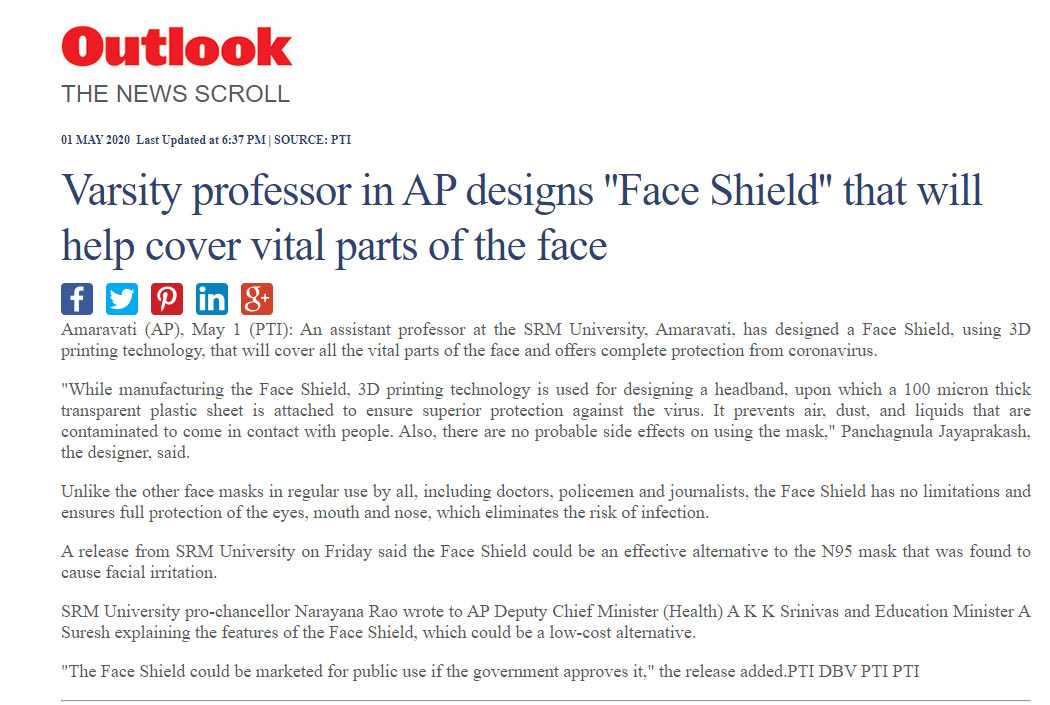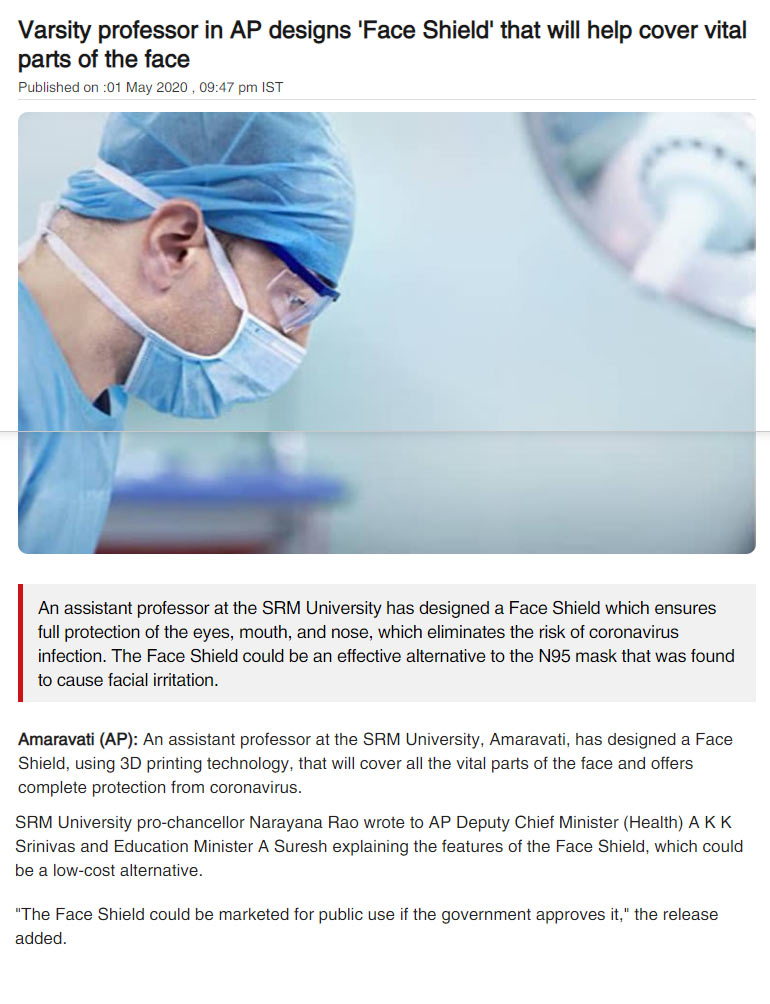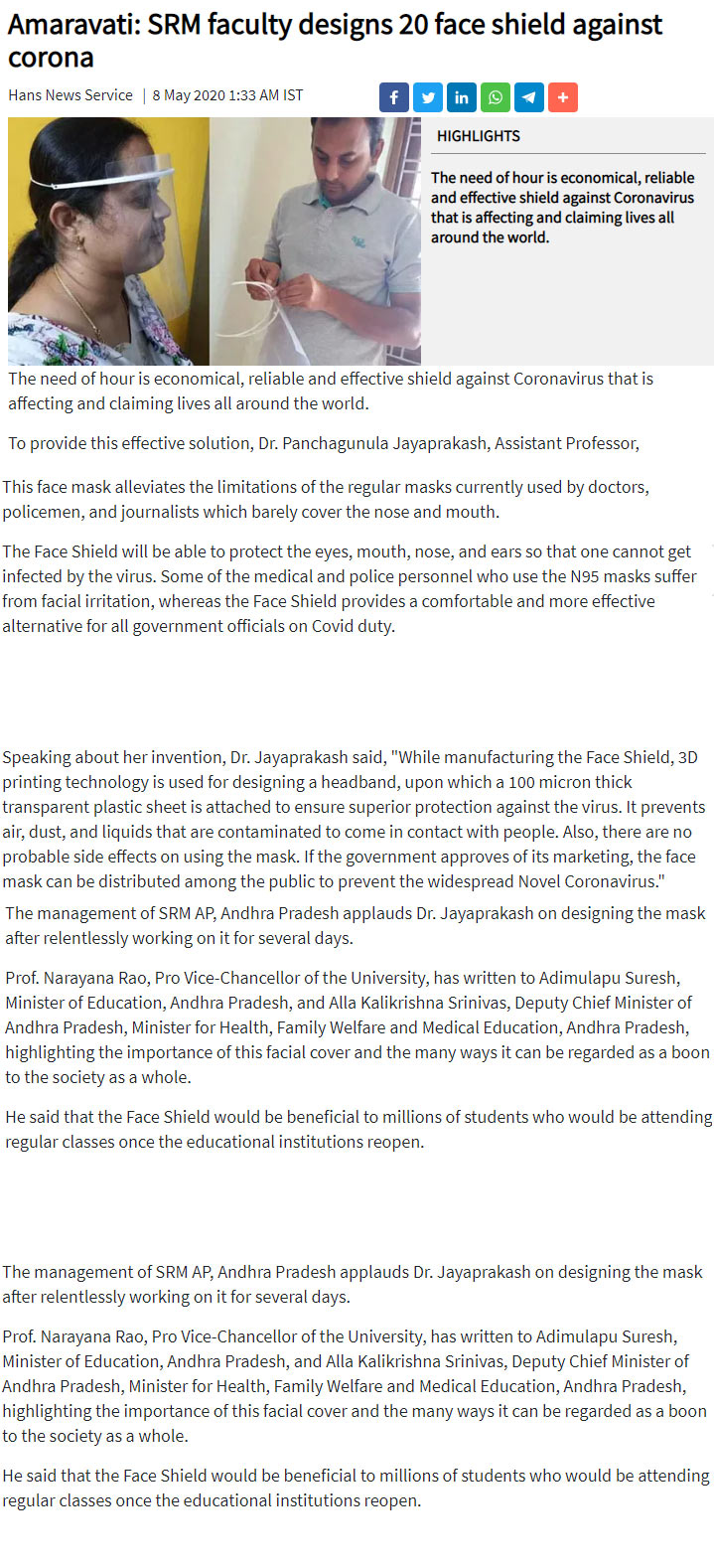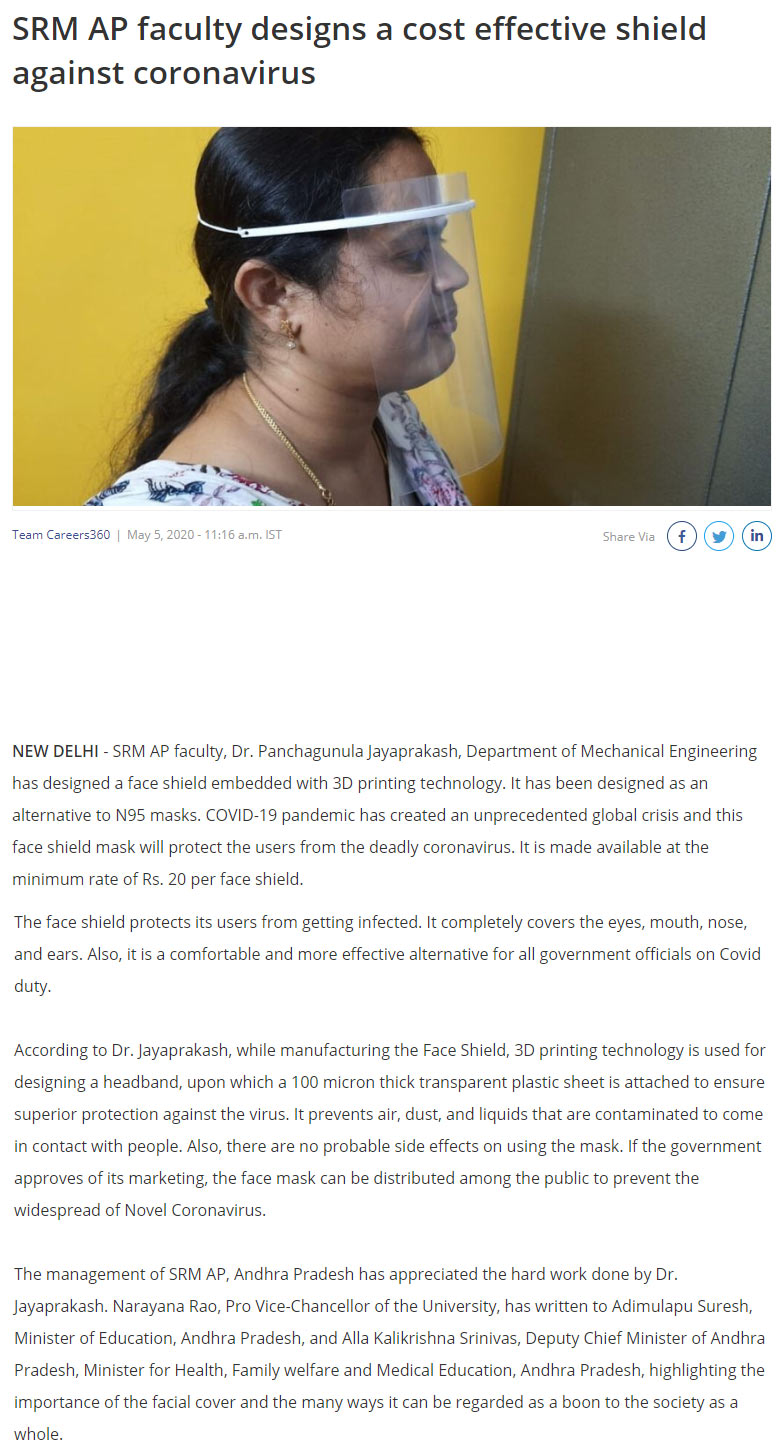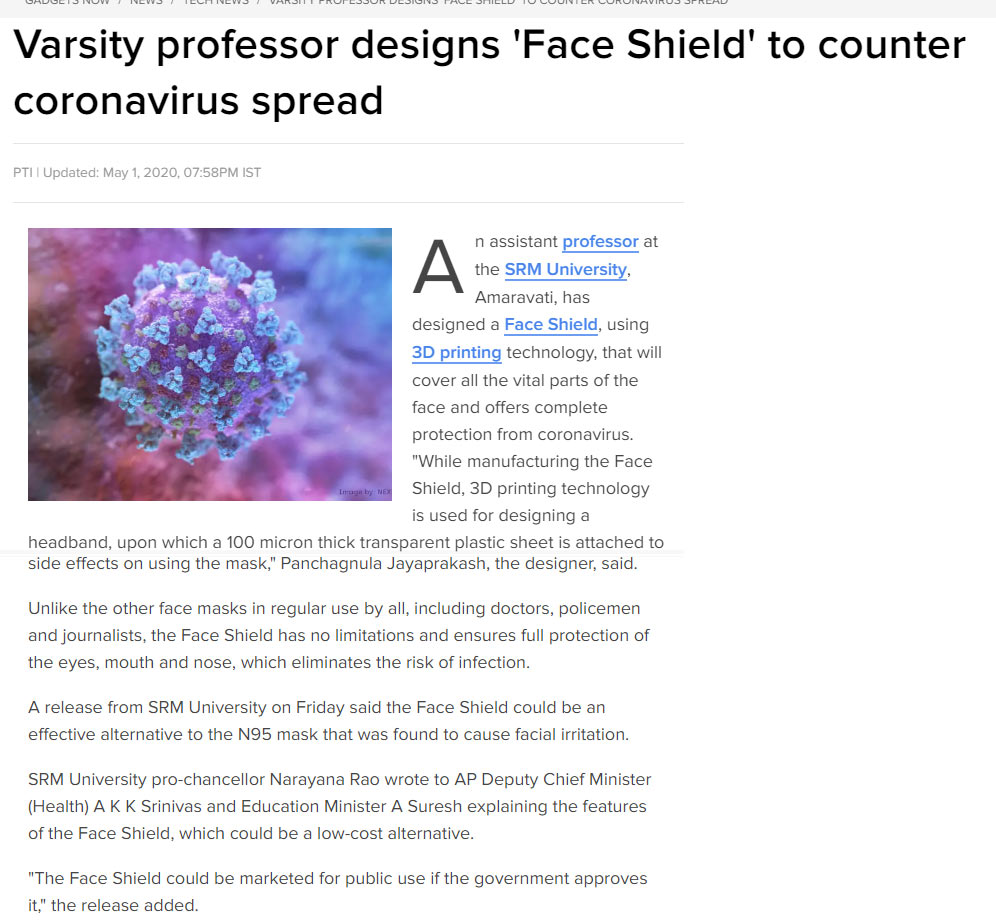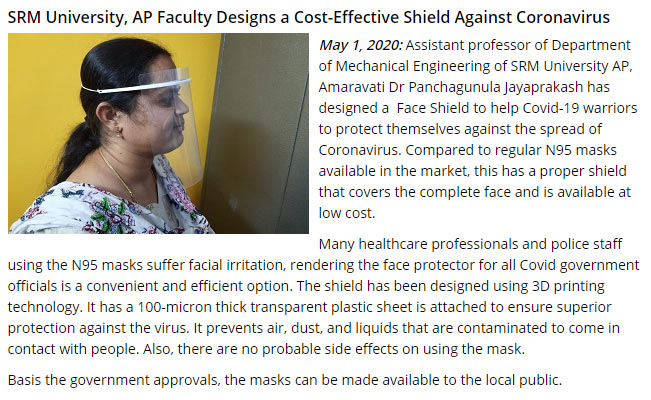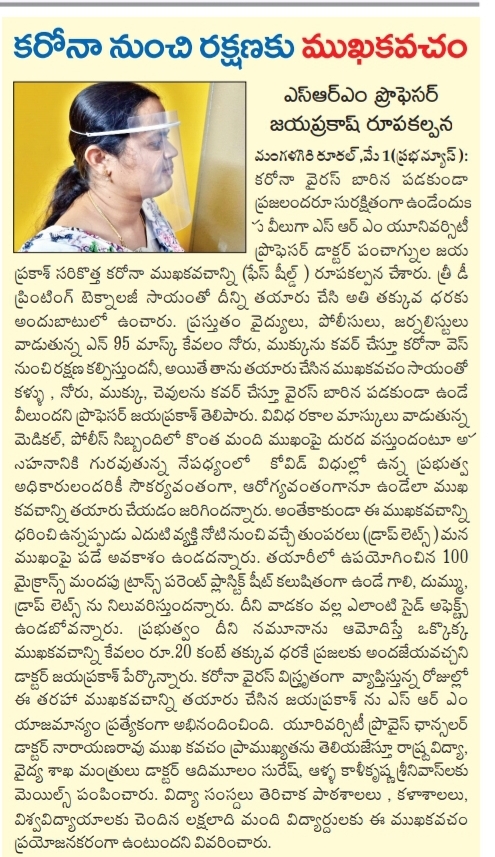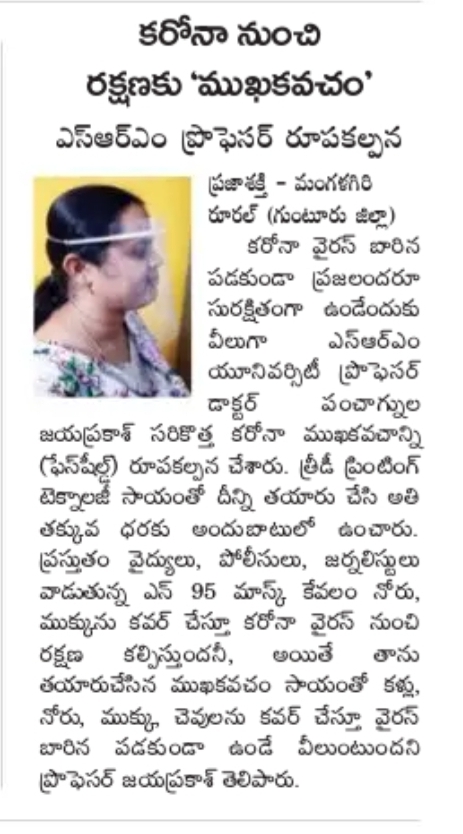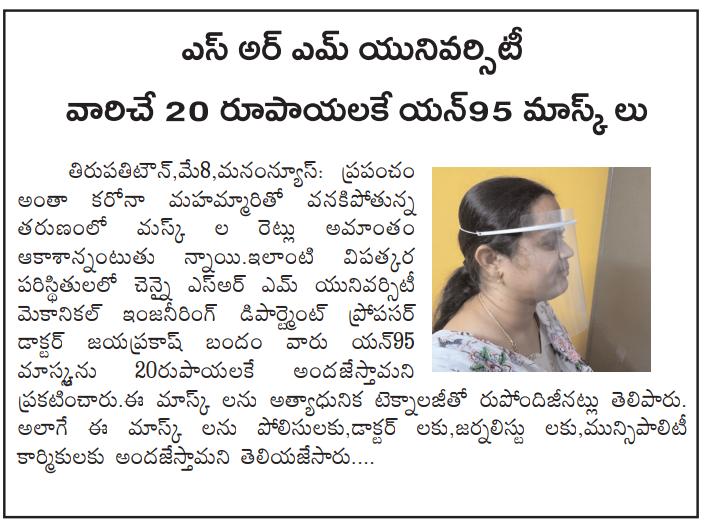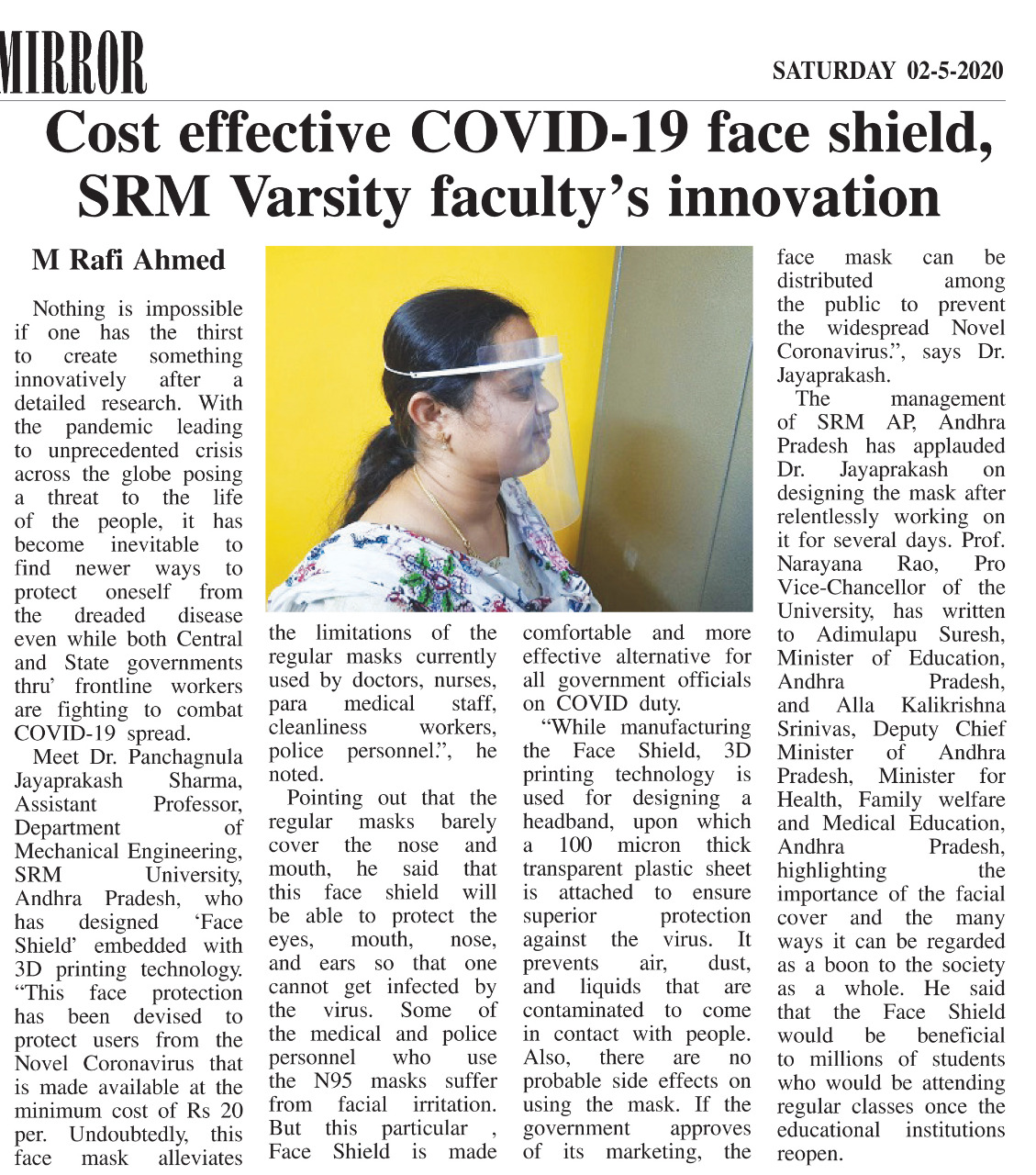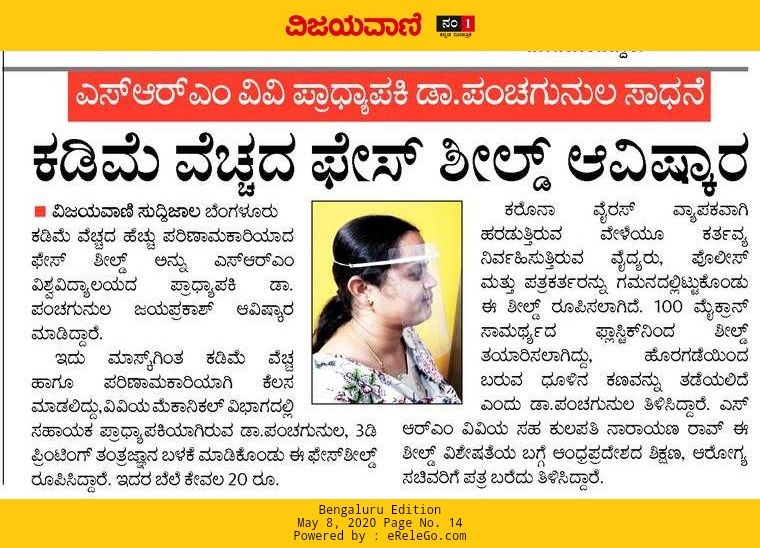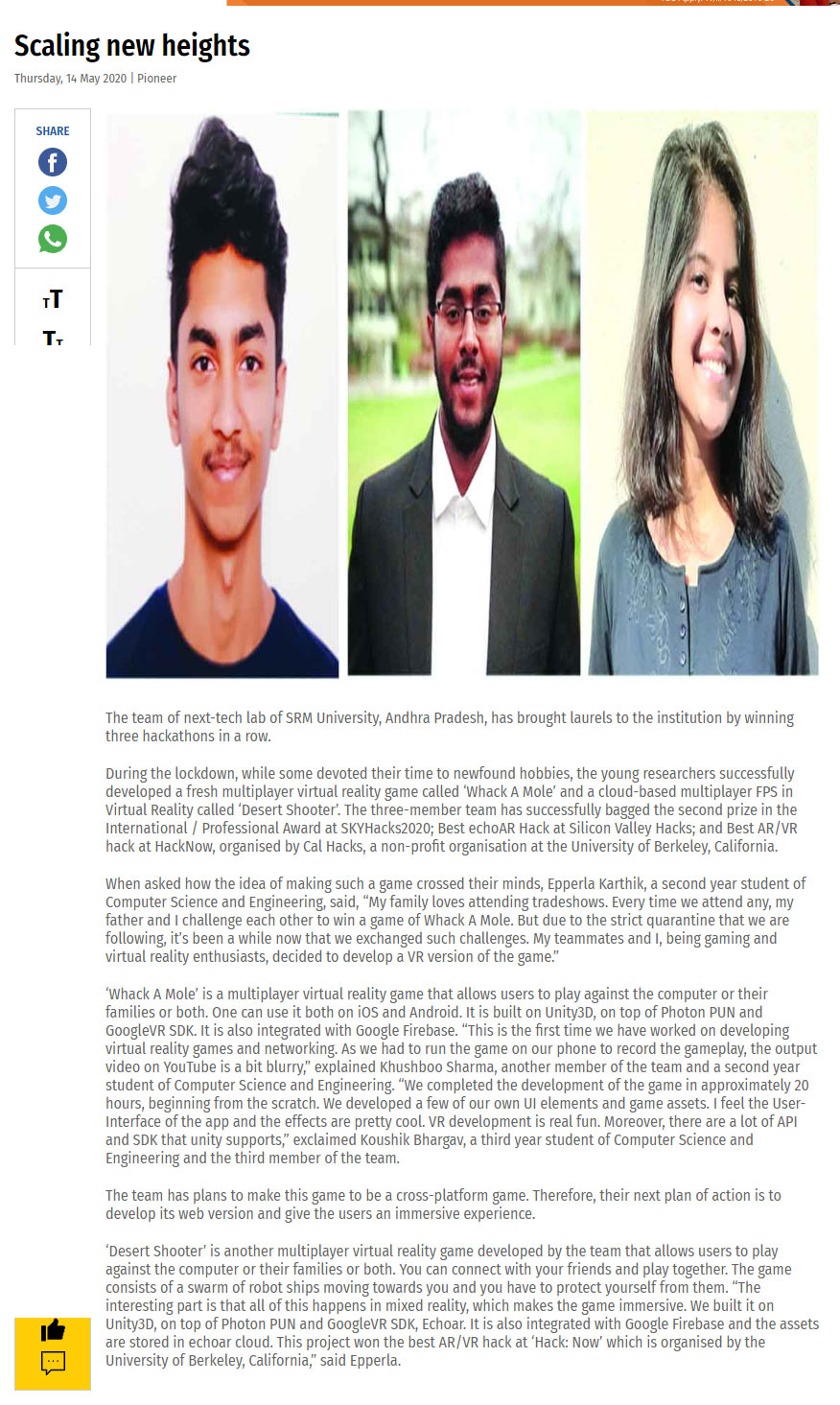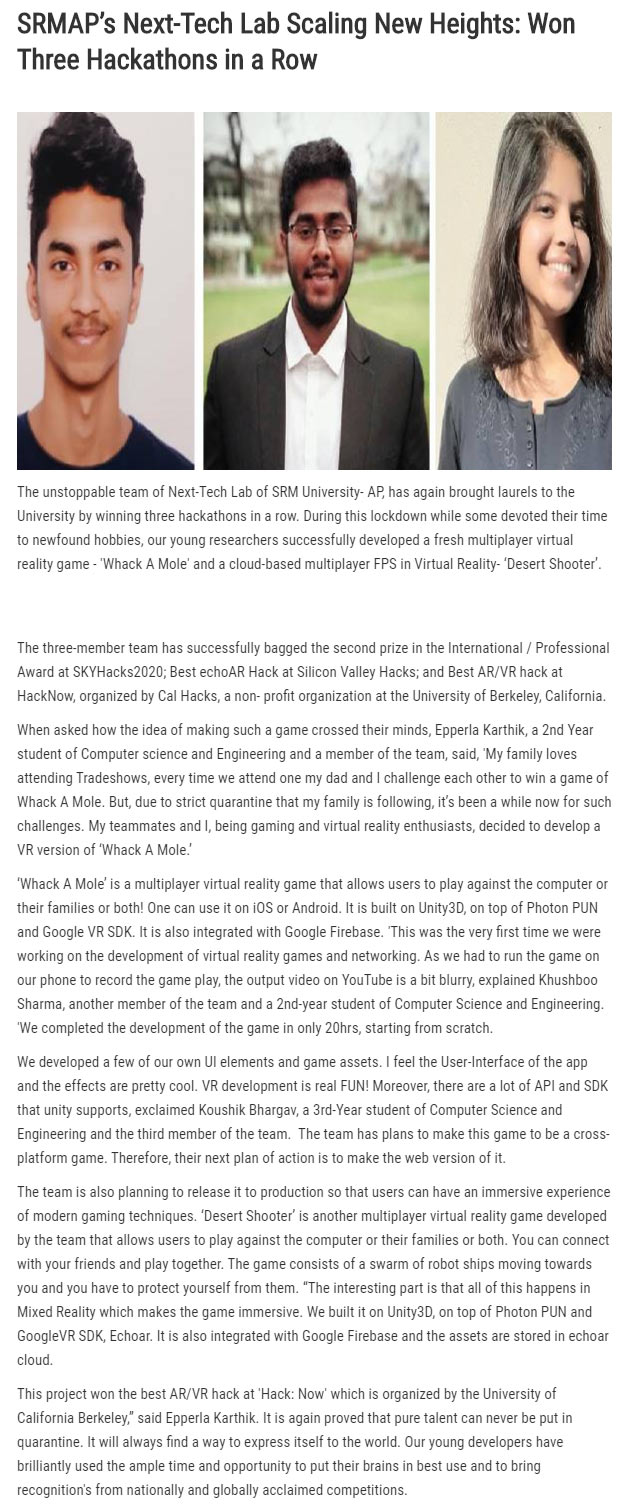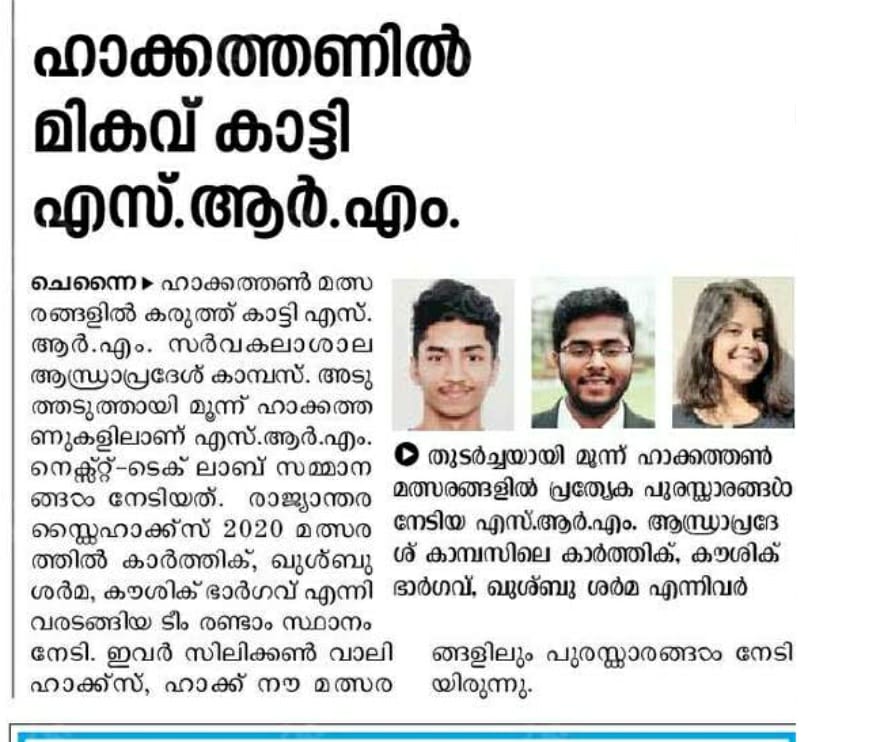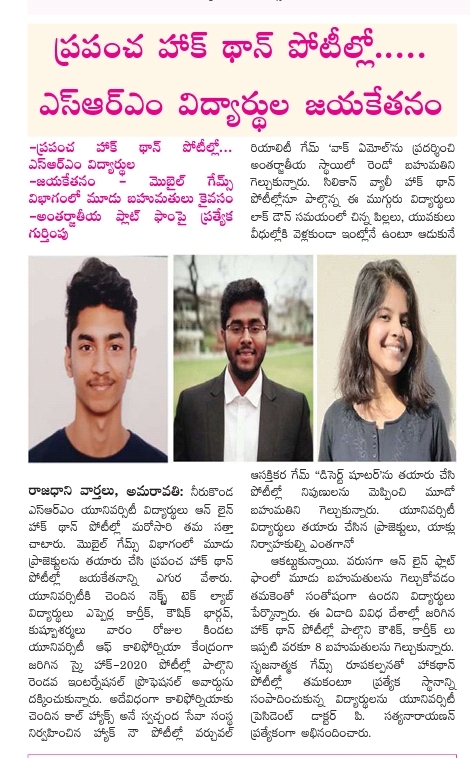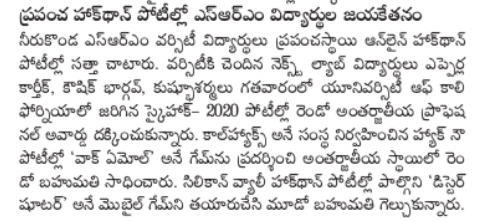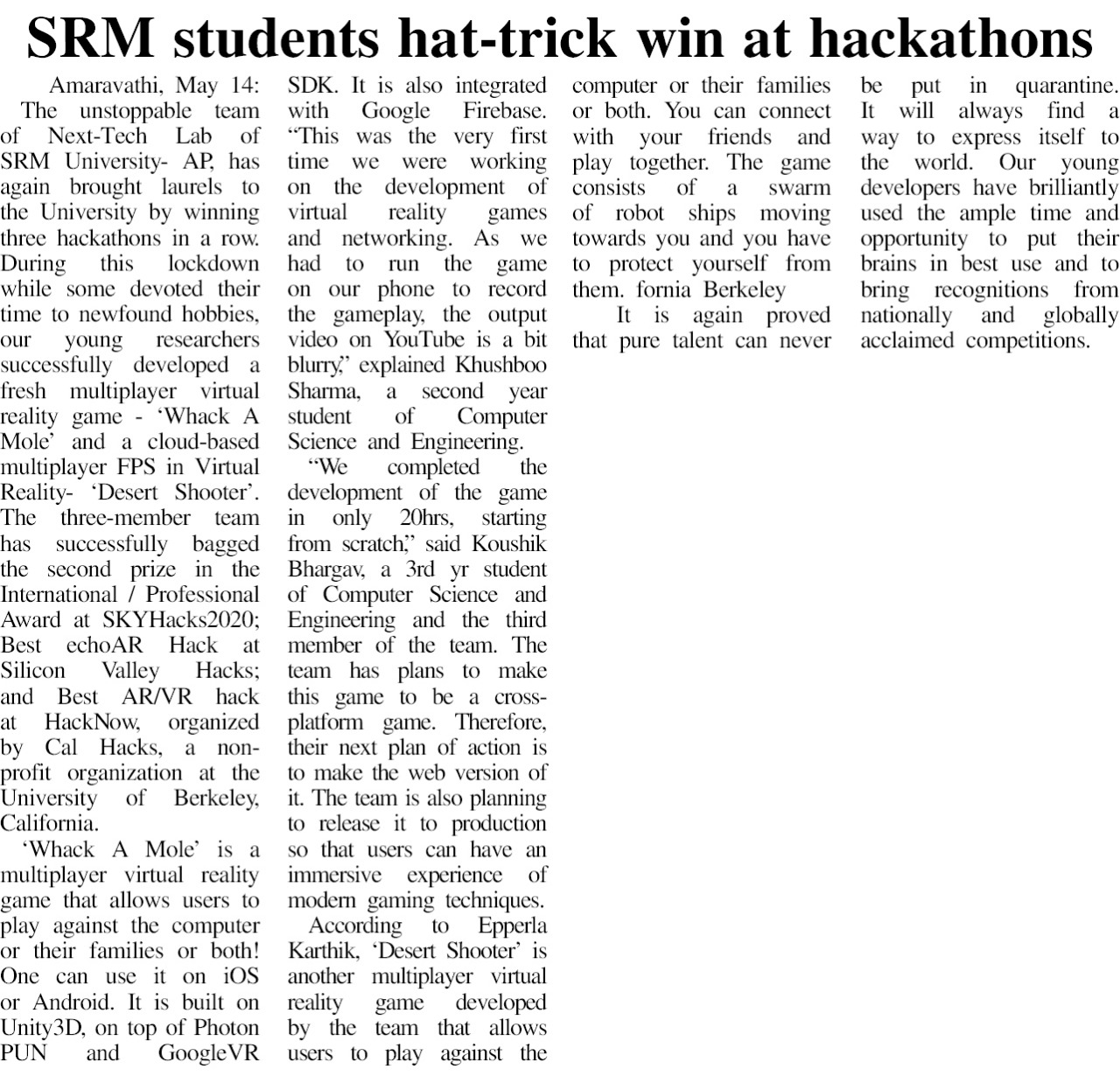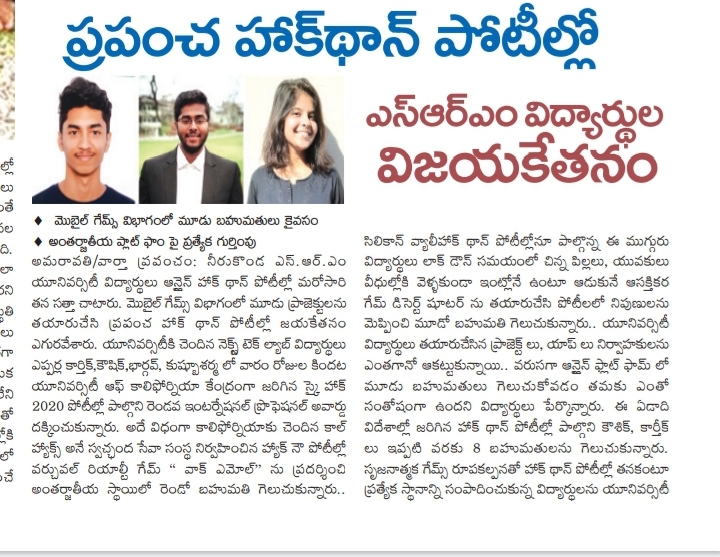- British Council award May 17, 2020
- Covid-19 face shield May 17, 2020
- Three Hackathons May 17, 2020
- “India should be competitive in terms of quality, quantity, and cost”- Dr. V K Saraswat May 15, 2020
A webinar on: Post COVID 19: Resurgence of Indian Industries and R&D
The pandemic in the form of Covid-19 has shaken the entire world and is believed to re-shape the economy, industrial strategies in a post-Covid situation. SRM AP conducted a webinar with eminent personalities to discuss the Post-Covid 19: Resurgence of Indian Industries and R&D. The panelists were Dr. V K Saraswat, Hon’ble member, NITI AAYOG, Chairman, Prof. D Narayana Rao, Pro VC, SRM AP, moderator and convener, Dr. G Satheesh Reddy, Chairman, DRDO, Prof. Ashok Jhunjhunwalaa, Institute Professor, IIT Madras, Dr. K Varaprasad Reddy, Chairman Emeritus, Shanta Biotechnics, Ltd, Prof. Prasant Mohapatra, VC Research, UC Davis, USA, Prof. Damodar Acharya, Ex- Director, IIT Kharagpur, Prof. V.S. Rao, President, NIIT University, Prof. B.S. Murty, Director, IIT Hyderabad, DR. Akhilesh Gupta, Adviser/Scientist-G, DST, Prof. Rakesh K Khandal, President R&D and Business Development, India Glycols LTD.
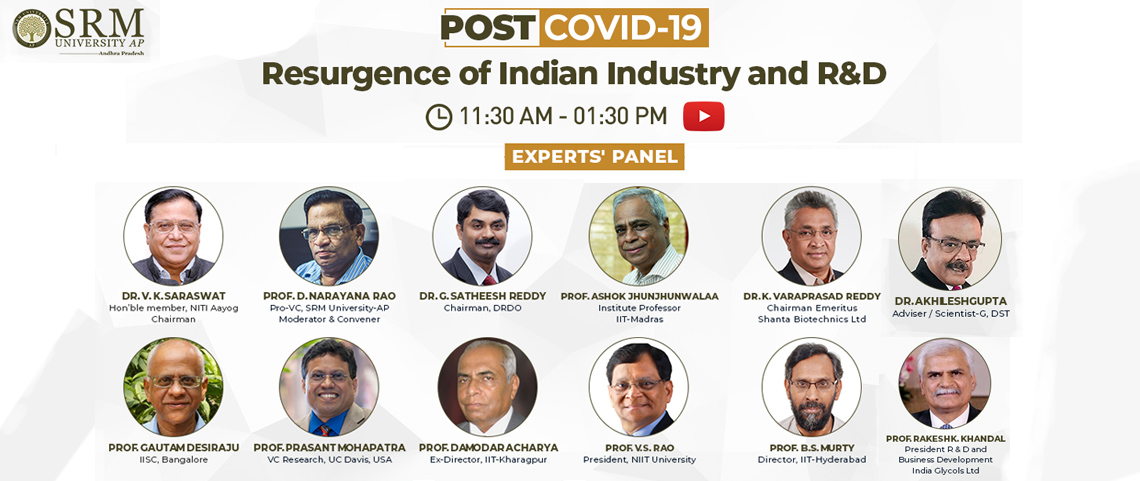
While welcoming the panelists and the participants of the webinar, Prof. D Narayana Rao, Pro Vice Chancellor, SRM University, AP, moderator and convener, says, “COVID 19 has disrupted the world and the world is struggling against the Virus. At the same time, COVID 19 is giving an unenvisaged opportunity in building a new India. It is inevitable that the world will shift from China to India for imports. India emerges as an alternative source to countries like the US, Japan, Singapore, and Taiwan. More than 300 MNCs will export via India instead of China. India needs to utilize this opportunity by building taskforce, infrastructure, and dedicated industrial fast track clearances. Further He said that India should develop the future Workforce for the World.”
Dr. V K Saraswat, Hon’ble member, NITI AAYOG, Chairman has talked about the capability of our scientific community in mitigating the crisis through epidemiological studies, stimulation and gene concepts. He further says, “The commitment of scientific community, institutions, DST, ICMR, DRDO, IITs, and pharmaceutical industries have been incredible in the battle against this raging pandemic.”
However, according to Dr. V K Saraswat, India exhibited delays in setting up of test centers, and supply chain problems require revamping and correction. He suggests, “Bringing down the interest rate, funding to industry R&D consortia, setting up R&D centers/labs, development of robotics embedded with IoT, tax breaks to Indian companies outside India, and upgrading testing labs is crucial. India centric epidemic preparedness, vibrant electronic device manufacturing ecosystem, medical devices, E-commerce, genetically modified crops, cybersecurity should also be implemented and improved to thrive in a post Covid-19 situation. “
He informs that Apron and textiles, automobile sector, Tourism and aviation, building construction, food and agriculture, finance, education, retail, and MSMEs alone with 30% of GDP contribution and providing employment to 140 million employees, will be most affected. “Understanding sector-wise business imperative and developing appropriate policy support to unconventional strategies will be the pivotal point for the revival of Indian economy.”, says Dr. V K Saraswat.
Dr. G Satheesh Reddy applauded the response of the country to fight against Covid-19. He says, “PPE, Masks, and Ventilator production has increased exponentially. Various industries are coming forward to submit designs for ventilators which were minimally used till the outbreak of coronavirus. The onus is to produce 60k ventilators in the coming days.” He further suggests, “We should have collaborations with industries abroad, acquire technical know-how, and become self-reliant eventually “.
Prof. Prasant Mohapatra says, “Higher education needs to focus more on innovation and creativity. Whereas South Korea invests 5%of GDP on R&D, India only invests 0.85%, exhibiting a huge opportunity for investment on R&D. Indians have high intellectual capital and focusing on high-quality education system will improve the R&D results of the country”. Dr. Akhilesh Gupta spoke of the extramural R&D. He says, “India needs to quadruple present full-time researchers to increase R&D spending to 2%”.
Dr. K Varaprasad Reddy believes that MNC’s should be compelled to share the research knowledge inferred in our land. Also, he instructs, “We need to reorient ourselves to combat against plausible bio attacks in the future”. Prof. B.S. Murty identifies that Internet and network connectivity with good speed and bandwidth should be provided to everyone at affordable price, as education is likely to get digitized in the future and the world has recognized its benefits during the outbreak of COVID 19. Meanwhile, Rakesh Khandal says, “Technology status appraisal should be prepared to identify the capabilities we have today in India. Also, funding to universities on R&D should be based on real content.” He further claims, “Traditional health systems like Ayurveda should be used to improve immunity and combat COVID”.
Dr. V K Saraswat concluded by saying, “India should be competitive in terms of quality, quantity, and cost effective by standardizing the products and settling for larger value addition.” The webinar highlighted the reversal of brain drain during this pandemic as intellectuals and workers have moved back to their hometown. Further, Young entrepreneurs who have mastered modern tools and are more connected to the world should be working with the academy and industry as they come up with solutions and develop technology rapidly. At the same time, it is vital to identify that we might need to live with Covid-19 for a long time, which requires self-sanitized logistics and public transport, robotics in hospitals, developing social distancing equipment, and drugs to improve immunity.
Continue reading → - Online adaptive fast output voltage tracking in DC power supply system May 15, 2020
Remarkable research of Dr. Tousif Khan N is honoured with APJ Abdul Kalam Memorial International Travel Award
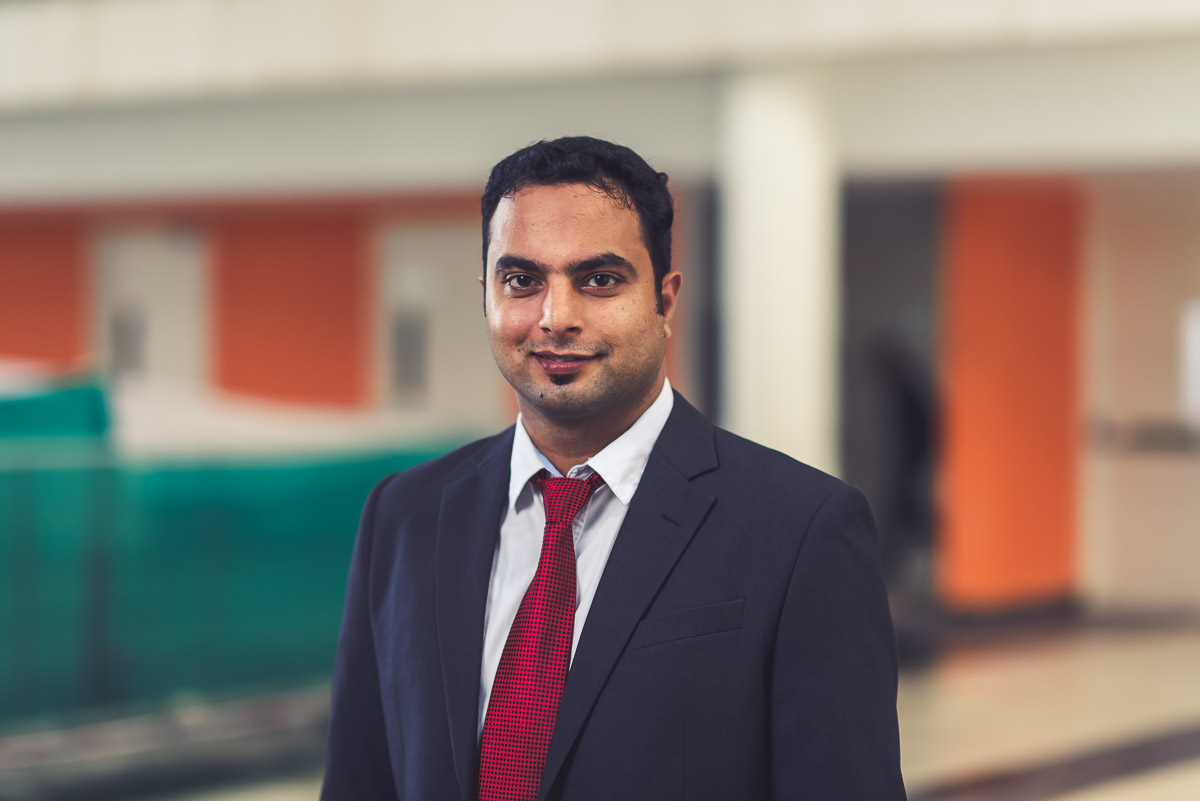 SRM University AP, Andhra Pradesh faculty, Dr. Tousif Khan N, Assistant Professor and Head of the Department, Department of Electrical and Electronics Engineering, is to present a paper “Laguerre Neural Network Driven Adaptive Control of DC-DC Step Down Converter” in the renowned International Federation for Automatic Control (IFAC) World Congress to be held in Germany during July 12-17, 2020. Further this research article is also selected for the prestigious APJ Abdul Kalam Memorial International Travel Award by the Automatic Control and Dynamic Optimization Society (ACDOS) chaired by Professor Ravi Gudi of Indian Institute of Technology Bombay.
SRM University AP, Andhra Pradesh faculty, Dr. Tousif Khan N, Assistant Professor and Head of the Department, Department of Electrical and Electronics Engineering, is to present a paper “Laguerre Neural Network Driven Adaptive Control of DC-DC Step Down Converter” in the renowned International Federation for Automatic Control (IFAC) World Congress to be held in Germany during July 12-17, 2020. Further this research article is also selected for the prestigious APJ Abdul Kalam Memorial International Travel Award by the Automatic Control and Dynamic Optimization Society (ACDOS) chaired by Professor Ravi Gudi of Indian Institute of Technology Bombay. The research work of Dr. Tousif proposes a novel Laguerre neural network estimation technique for the approximation of unknown and uncertain load function, followed by its subsequent compensation in the adaptive backstepping controller. A detailed design of the proposed estimator and adaptive backstepping controller along with closed loop asymptotic stability have been presented. Further, the proposed control mechanism is evaluated through extensive numerical simulations while subjecting the converter to input voltage, reference voltage, and load resistance perturbations. Furthermore, the results are verified by testing the proposed controller on a laboratory prototype with DSP based TM320F240 controller board. The analysis of results reveals that the proposed control methodology for DC-DC step down converter offers a faster transient output voltage tracking with smooth and satisfactory inductor current response over a wide operating range. Dr. Tousif informs, “Under the class of DC-DC converters, the dynamics of DC-DC step down converter are nonlinear in nature and are largely influenced by both parametric and unanticipated external perturbations. In its closed loop operation, obtaining a precise output voltage tracking besides satisfactorily inductor current response is a challenging control objective. Hence, in this regard, this article proposes a solution.”
Electric power supply is the principal entity behind any electrical circuits and systems. Irrespective of their function in the digital domain, these circuits necessarily require a reliable and efficient energy source for their operations. Among the two existing forms of electrical energy, namely, the direct current (DC) and the alternating current (AC), the DC power finds wide use in numerous applications in the field of telecommunication, instrumentation, medical electronics, aerospace, defence and power transmission.
Ever since the fundamental innovations in DC systems by Thomas Alva Edison in 1880, DC rectification, and modulation method have remained central to various utilities. During the initial years, DC power conversion primarily resorted to the use of vacuum tube technology in delivering a desirable level of voltage from an AC source. The rectification stage was subsequently followed by filtering of the voltage at the output end. Nonetheless, the vacuum tube technology supported very low current density and featured a high ripple content in the DC voltage. Additionally, the output voltage was inconsistent or rather unregulated, making it inappropriate for DC power operated electrical and electronic systems. Much later in 1967, integrated series regulators were developed which eventually became popular as linear power supplies (LPS). Such a classical DC power generation method involved an AC transformer, AC-DC rectifier, and a voltage regulator in its assembly. The transistors in LPS operate under active region and dissipate large amounts of heat due to the voltage drop while high current flows through the collector-emitter junction, thereby causing substantial power loss and a very low energy efficiency. Even though they characterize the low level of noise and find better suitability in audio applications, yet their critical limitations of huge size, heavy weight and high cost make them infeasible for use in portable electronic devices.
In tandem to these aforementioned developments, the advancements in power semiconductor technology led to the invention of low cost reliable power switches exhibiting fast switching response. This proved to be instrumental in building an energy efficient switched mode power supply which gradually gained popularity. “Its impact on electrical technology was phenomenal, replacing conventional linear voltage supplies with switched mode power supplies giving rise to enhanced efficiency, light weight, compactness, and comparably lower cost. Such a modern DC conversion system primarily includes DC-DC converters, wherein the rectified input voltage is fed to the DC-DC converter circuits for obtaining specific voltage levels. The primary objective in DC-DC converters is to transfer the energy among different DC circuits functioning at a specific voltage and current levels. This process of energy transfer is performed by temporarily storing the energy from the input source in an operating mode, followed by releasing it in the other operational mode of the converter. Thus, one level of DC input voltage is converted to another level of average DC output voltage at the load end. Meanwhile, the converter being ideal is expected to consume no energy. Any consumption of energy in the converter interface amounts to direct power loss in the overall supply system. Typically, converters render high input-output conversion.”, enlightens Dr. Tousif Khan N. His notable research work offers to mitigate these issues, leading to the venerated APJ Abdul Kalam Memorial International Travel Award. Advancing his work in the future, Dr. Tousif will be closely working on the society’s activities with ACDOS as a member for mutual benefit.
Continue reading →


